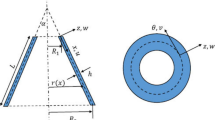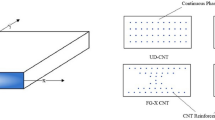Abstract
The aim of the present paper is to investigate the buckling and post-buckling behaviour of nanocomposite plate having randomly oriented carbon nanotubes (CNTs) reinforced in magnesium (Mg) under uni-axial compression. The effect of non-bonded interaction at the interface between CNT and matrix is considered through a cohesive zone model, used to predict the elastic property of the interphase, while evaluating the elastic properties of the nanocomposite using a representative volume element. A special purpose program based on finite-element formulation is developed to study the buckling and post-buckling behaviour of nanocomposite plate. The formulation is based on first-order shear deformation theory in conjunction with geometrical non-linearity as per von Karman’s assumptions. A parametric study is conducted to investigate the effects of interphase between CNT and matrix, short-CNT and long-CNT reinforcements and boundary conditions on buckling and post-buckling response of nanocomposite plate. It is found that imperfect bonding between CNT and Mg results in the loss of buckling and post-buckling strength, as compared with perfect bonding, of CNT–Mg nanocomposite plate. It is also concluded that buckling and post-buckling strength is higher for long-CNT-reinforced nanocomposite plate than that of short-CNT reinforcement, irrespective of bonding between CNT and matrix material.









Similar content being viewed by others
References
Esawi A M K and Farag M M 2007 Carbon nanotube reinforced composites: potential and current challenges. Mater. Des. 28: 2394–2401
Iijima S 1991 Helical microtubules of graphitic carbon. Nature 354: 56–58
Salvetat J P, Bonard J M, Thomson N H, et al 1999 Mechanical properties of carbon nanotubes. Appl. Phys. A Mater. Sci. Process. 69: 255–260
Fiedler B, Gojny F H, Wichmann M H G, et al 2006 Fundamental aspects of nano-reinforced composites. Compos. Sci. Technol. 66: 3115–3125
Esawi A M K, Morsi K, Sayed A, et al 2010 Effect of carbon nanotube (CNT) content on the mechanical properties of CNT-reinforced aluminium composites. Compos. Sci. Technol. 70: 2237–2241
Bakshi S R and Agarwal A 2010 An analysis of the factors affecting strengthening in carbon nanotube reinforced aluminum composites. Carbon 49: 533–544
Yang M, Koutsos V and Zaiser M 2005 Interactions between polymers and carbon nanotubes: a molecular dynamics study. J. Phys. Chem. B 109: 10009–10014
Zhang Y, Zhuang X, Muthu J, et al 2014 Load transfer of graphene/carbon nanotube/polyethylene hybrid nanocomposite by molecular dynamics simulation. Composites Part B 63: 27–33
Choi J, Shin H and Cho M 2016 A multiscale mechanical model for the effective interphase of SWNT/epoxy nanocomposite. Polymer 89: 159–171
Joshi P and Upadhyay S H 2014a Effect of interphase on elastic behavior of multiwalled carbon nanotube reinforced composite. Comput. Mater. Sci. 87: 267–273
Liu Y J and Chen X L 2003a Evaluations of the effective material properties of carbon nanotube-based composites using a nanoscale representative volume element. Mech. Mater. 35: 69–81
Liu Y J and Chen X L 2003b Continuum models of carbon nanotube-based composites using the boundary element method. Electron. J. Bound. Elem. 1: 316–335
Joshi U A, Sharma S C and Harsha S P 2011 Effect of waviness on the mechanical properties of carbon nanotube based composites. Phys. E. Low-dim. Syst. Nanostruct. 43:1453–1460
Shokrieh M M and Rafiee R 2010a On the tensile behavior of an embedded carbon nanotube in polymer matrix with non-bonded interphase region. Compos. Struct. 92: 647–652
Joshi P and Upadhyay S H 2014b Evaluation of elastic properties of multi-walled carbon nanotube reinforced composite. Comput. Mater. Sci. 81: 332–338
Tsai J L, Tzeng S H and Chiu Y T 2010 Characterizing elastic properties of carbon nanotubes/polyimide nanocomposites using multi-scale simulation. Composites Part B 41: 106–115
Herasati S, Zhang L C and Ruan H H 2014 A new method for characterizing the interphase regions of carbon nanotube composites. Int. J. Solids Struct. 51: 1781–1791
Shokrieh M M and Rafiee R 2010b Prediction of mechanical properties of an embedded carbon nanotube in polymer matrix based on developing an equivalent long fiber. Mech. Res. Commun. 37: 235–240
Rafiee R and Pourazizi R 2015 Influence of CNT functionalization on the interphase region between CNT and polymer. Comput. Mater. Sci. 96: 573–578
Odegard G M, Clancy T C and Gates T S 2005 Modeling of the mechanical properties of nanoparticle/polymer composites. Polymer 46: 553–562
Jiang L Y, Huang Y, Jiang H, et al 2006 A cohesive law for carbon nanotube/polymer interfaces based on the van der Waals force. J. Mech. Phys. Solids 54: 2436–2452
Tan H, Jiang L Y, Huang Y, et al 2007 The effect of van der Waals-based interface cohesive law on carbon nanotube-reinforced composite materials. Compos. Sci. Technol. 67: 2941–2946
Zhao J, Jiang J W, Jia Y, et al 2013 A theoretical analysis of cohesive energy between carbon nanotubes, graphene and substrates. Carbon 57: 108–119
Zhang Y, Zhao J, Jia Y, et al 2013 An analytical solution on interface debonding for large diameter carbon nanotube-reinforced composite with functionally graded variation interphase. Compos. Struct. 104: 261–269
Arani A G, Maghamikia S, Mohammadimehr M and Arefmanesh A 2011 Buckling analysis of laminated composite rectangular plates reinforced by SWCNTs using analytical and finite element methods. J. Mech. Sci. Technol. 25: 809–820
Jafari Mehrabadi S, Sobhani Aragh B, Khoshkhahesh V, Taherpour A 2012 Mechanical buckling of nanocomposite rectangular plate reinforced by aligned and straight singlewalled carbon nanotubes. Compos Part B Eng 43: 2031–2040
Lei Z X, Liew K M, Yu J L 2013 Buckling analysis of functionally graded carbon nanotube-reinforced composite plates using the element-free kp-Ritz method. Compos Struct 98: 160–168
Shen H S and Zhang C L 2010 Thermal buckling and postbuckling behavior of functionally graded carbon nanotube-reinforced composite plates. Mater. Des. 31: 3403–3411
Shen H S and Zhu Z H 2012 Postbuckling of sandwich plates with nanotube-reinforced composite face sheets resting on elastic foundations. Eur. J. Mech. A/Solids 35: 10–21
Boda D and Henderson D 2008 The effects of deviations from Lorentz–Berthelot rules on the properties of a simple mixture. Mol. Phys. Int. J. Interface Between Chem. Phys. 106: 2367–2370
White A 2000 Intermolecular potentials of mixed systems: testing the Lorentz–Berthelot mixing rules with ab initio calculations. DSTO-TN-0302
Sears A and Batra R C 2004 Macroscopic properties of carbon nanotubes from molecular-mechanics simulations. Phys. Rev. B 69: 235406
Sun C T, Vaidya R S 1996 Prediction of composite properties from a representative volume element. Compos Sci Technol 56: 171–179
Tsai S W and Pagano N J 1968 Invariant properties of composite materials. In: Composite Materials Workshop Proceedings. Technomic Publishing Co.
Kunanopparat T, Menut P, Morel M H and Guilbert S 2008 Plasticized wheat gluten reinforcement with natural fibers: effect of thermal treatment on the fiber/matrix adhesion. Compos. Part A Appl. Sci. Manuf. 39: 1787–1792
Stern T, Teishev A and Marom G 1997 Composites of polyethylene reinforced with chopped polyethylene fibers: effect of transcrystalline interphase. Compos. Sci. Technol. 57: 1009–1015
Joshi U A, Joshi P, Harsha S P and Sharma S C 2010 Evaluation of the mechanical properties of CNT based composites using hexagonal RVE. J. Nanotechnol. Eng. Med. 1: 1–7
Kumar P and Srinivas J 2014 Numerical evaluation of effective elastic properties of CNT-reinforced polymers for interphase effects. Comput. Mater. Sci. 88: 139–144
Tucker C L and Liang E 1999 Stiffness predictions for unidirectional short-fiber composites: review and evaluation. Compos. Sci. Technol. 59: 655–671
Hu Z, Arefin M R H, Yan X and Fan Q H 2014 Mechanical property characterization of carbon nanotube modified polymeric nanocomposites by computer modeling. Compos. Part B Eng. 56: 100–108
Fan J 2011 Mutiscale analysis of deformation and failure of materials. John Wiley & Sons Ltd, New York.
Bentor Y 2014. http://www.chemicalelements.com/index.html. Accessed 5 Jan 2016
Lu W B, Wu J, Song J, et al 2008 A cohesive law for interfaces between multi-wall carbon nanotubes and polymers due to the van der Waals interactions. Comput. Methods Appl. Mech. Eng. 197: 3261–3267
Kumar D and Singh S B 2010 Effects of boundary conditions on buckling and postbuckling responses of composite laminate with various shaped cutouts. Compos. Struct. 92: 769–779
Reddy J N 2004a Mechanics of laminated composite plates and shells, second ed. CRC Press, Boca Raton
Reddy J N 2004b An introduction to nonlinear finite element analysis. Oxford University Press, Oxford
Sundaresan P, Singh G and Venkateswara Rao G 1996 Buckling and post-buckling analysis of moderately thick laminated rectangular plates. Comput. Struct. 61: 79–86
Le-manh T and Lee J 2014 Postbuckling of laminated composite plates using NURBS-based isogeometric analysis. Compos. Struct. 109: 286–293
Author information
Authors and Affiliations
Corresponding author
Nomenclature
- \( \phi \)
-
cohesive energy
- σ
-
van der Waals radius
- ε
-
bond energy at equilibrium distance
- r
-
distance between the particles
- \( \rho_{\text{C}} \)
-
area density of CNT
- \( \rho_{m} \)
-
volume density of matrix material
- \( h_{0} \)
-
equilibrium distance between the nanofiller and matrix material
- E
-
elastic modulus
- S
-
strain
- a
-
side of square RVE
- L
-
length of RVE
- \( \sigma_{ij} , \varepsilon_{kl} \) and \( C_{ijkl} \)
-
stress, strain and stiffness tensor, respectively
- \( \overline{\sigma _{ij}} \) and \( \overline{\varepsilon _{kl}} \)
-
volumetric average of stress and strain of RVE
- \( C_{ijkl}^{e} \)
-
effective stiffness tensor
- \( E_{1} \)
-
Young’s modulus in the axial direction of nanocomposite
- \( E_{2} \)
-
Young’s modulus in the transverse direction of nanocomposite
- V RVE
-
volume of represented volume element
- \( v_{f} \)
-
volume fraction for CNT
- r o and r i
-
external and internal radius of the CNT, respectively
- t
-
thickness of CNT
- r I
-
outer radius of interphase zone
- b
-
width of square plate
- h
-
thickness of square plate
- u, v and w
-
displacements in x, y and z directions, respectively
- θ x and θ y
-
rotation of normal to the undeformed mid-plane in xz- and yz-plane, respectively
- \( \bar{W} \)
-
normalized maximum transverse deflection
- N x
-
uni-axial edge compressive load
Rights and permissions
About this article
Cite this article
SRIVASTAVA, A., KUMAR, D. Post-buckling behaviour of carbon-nanotube-reinforced nanocomposite plate. Sādhanā 42, 129–141 (2017). https://doi.org/10.1007/s12046-016-0581-9
Received:
Revised:
Accepted:
Published:
Issue Date:
DOI: https://doi.org/10.1007/s12046-016-0581-9




